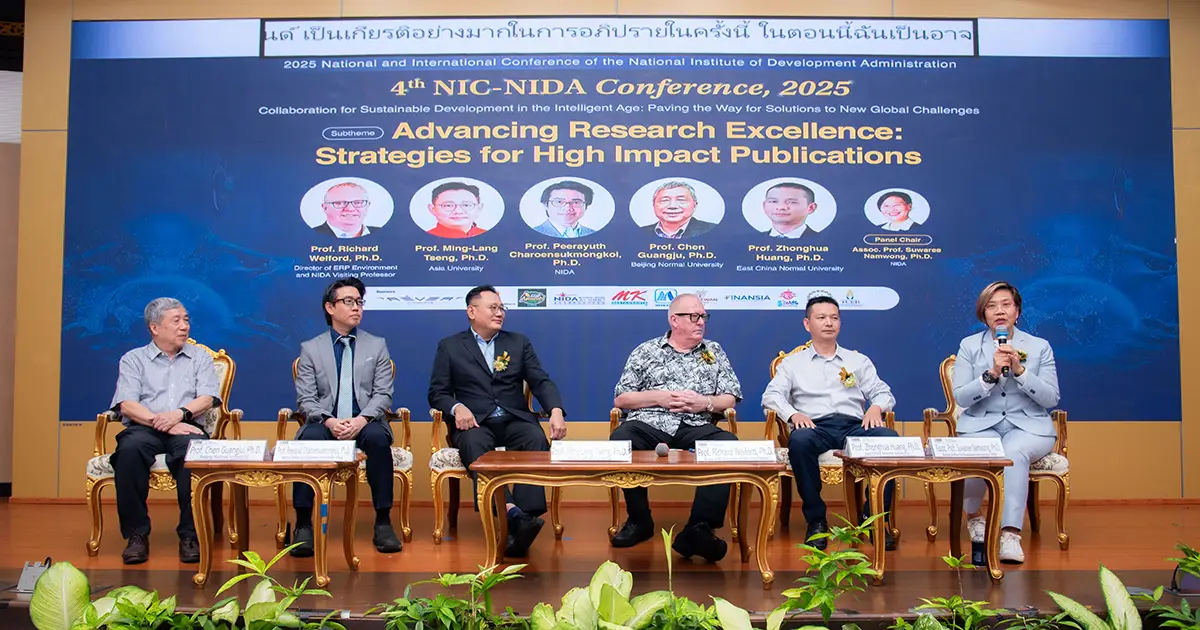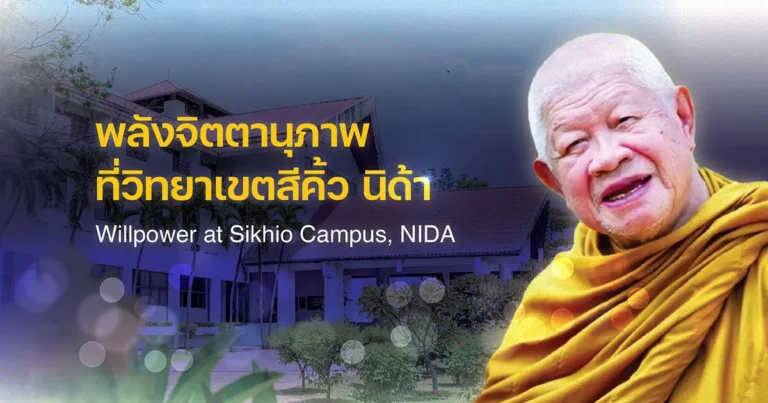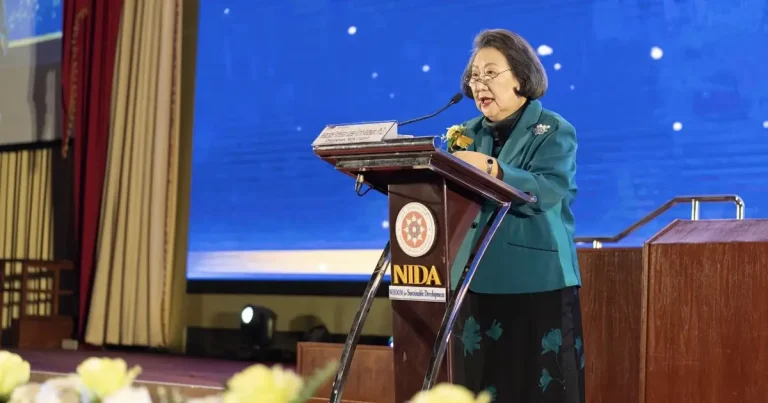by
Prof. Richard Welford, Ph.D. Director of ERP Environment and NIDA Visiting Professor
Prof. Ming-Lang Tseng, Ph.D. Asia University
Prof. Zhonghua Huang, Ph.D. East China Normal University
Prof. Chen Guangju, Ph.D. Beijing Normal University
Prof. Peerayut Charoensukmongkol, Ph.D. NIDA
Panel Chair: Assoc. Prof. Suwaree Namwong, Ph.D. NIDA
Summary of panel discussion highlights by
Prof. Wisakha Phoochinda, Ph.D.
The National Institute of Development Administration (NIDA) Annual National and International Conference 2025 featured a special keynote session titled “Advancing Research Excellence: Strategy for High Impact Publications,” creating an intellectual space to explore strategies for elevating research to international recognition and impact. The session commenced with an opening address by Assoc. Prof. Sombat Kusumavalee, Ph.D., Vice President for Academic and International Affairs, who clearly defined the framework of the discourse. In the contemporary academic landscape, he emphasized, research excellence is not merely measured by theoretical depth but also by its ability to create tangible impact on society, policy, and innovation. Therefore, the mission of academics must extend beyond generating knowledge within their disciplines to communicating that knowledge to create broader value.
Prof. Richard Welford, Ph.D., the executive editor of four leading international academic journals, offered invaluable insights from the strategic position of a knowledge gatekeeper. He stressed that the non-negotiable prerequisite is the “quality of research.” However, a critical initial factor that causes many researchers, especially emerging ones, to fail is neglecting a thorough study of a journal’s “Aims and Scope,” which is the primary reason for a high rate of desk rejections. He issued a stern warning about the perils of using Artificial Intelligence (AI) in academic writing, particularly the creation of “phantom references,” which constitutes academic misconduct and can lead to article retraction, permanently damaging an academic’s reputation. He advised researchers to seek out contemporary issues and avoid saturated topics, while also clarifying the distinctions between different types of Open Access journals—differentiating between reputable models and “pay-to-publish” schemes that require careful scrutiny.
Prof. Ming-Lang Tseng Ph.D. from Asia University, a highly cited scholar, shared his strategies for achieving demonstrable success. He emphasized the importance of a clear and coherent “Logical Flow” throughout the manuscript, coupled with demonstrable “Innovation and Contribution.” He explained that impactful research must “Fulfill the Gaps” in the existing body of knowledge, whether theoretical or methodological. One strategy he employs is applying established knowledge to new, globally relevant topics such as artificial intelligence, the circular economy, or sustainable development to create interest and broaden the scope of citation. He also reflected on his dedication through his intensive “Ming-Lang Tseng style” mentorship, confirming that great success demands unwavering commitment and discipline.
Prof. Peerayuth Charoensukmongkol, Ph.D. from NIDA conveyed his valuable experience from the perspective of a Thai researcher who has achieved success on the international stage. He applied the principles of Sun Tzu’s “Know thy enemy, know thyself” to academic publishing. “Knowing the enemy,” in this context, means deeply understanding the expectations of journals, reviewers, and editors, while “knowing thyself” involves an honest assessment of one’s own research capabilities and quality. He stressed that the most heavily weighted factors in evaluation are “Originality” and “Rigor” in methodology, which are more critical than eloquent writing skills. He also drew an inspiring connection between success and the “10,000-Hour Rule,” which posits that researchers must dedicate immense time and energy to honing their skills, viewing rejection not as failure but as a crucial part of the learning and refinement process.
Prof. Chen Guangju Ph.D. from Beijing Normal University creatively presented his ideas through a digital avatar, proposing a framework of the “Three Bigs”: Big Questions that can impact society at large, Big Data to build credibility and answer complex inquiries, and Big Tactics in analysis and presentation. This was complemented by the “Three Reals”: studying issues in the Real World, conducting a Real Study with integrity and transparency, and presenting a Real New Story that can generate new knowledge. He compared two of his own research papers to illustrate that, in addition to quality, “Contextual Timeliness” is a key factor in how quickly an impact is made.
Assoc. Prof. Suwaree Namwong, Ph.D., as the panel chair, concluded by summarizing the key takeaways. She cautioned researchers against predatory journals, which can undermine the credibility of their work, and emphasized the importance of maintaining a healthy work-life balance while cultivating the resilience needed for the lengthy and challenging peer-review process.
In conclusion, this special session synthesized a rich tapestry of insights from diverse perspectives, painting a comprehensive picture of what it takes to produce high-impact research. It underscored that success is not contingent on a single factor but is the result of a strategic framework that includes 1) a strong intellectual foundation characterized by unique originality and methodological rigor; 2) strategic acumen in selecting appropriate journals and understanding the audience; 3) strict adherence to academic ethics, especially in the age of AI; and 4) mental fortitude to face setbacks and learn from every experience. The discourse reaffirmed that the path to academic excellence is not merely a quest for knowledge but a journey that requires wisdom, strategy, integrity, and perseverance to translate research into a lasting and meaningful contribution to the global community.
การประชุมวิชาการระดับชาติและนานาชาติของสถาบันบัณฑิตพัฒนบริหารศาสตร์ (NIDA) ประจำปี 2568 ได้จัดให้มีการเสวนาพิเศษในหัวข้อ “Advancing Research Excellence: Strategy for High Impact Publications” ซึ่งเป็นการสร้างพื้นที่ทางปัญญาเพื่อตอบสนองยุทธศาสตร์ในการยกระดับผลงานวิจัยสู่การเป็นที่ยอมรับและสร้างผลกระทบในระดับสากล โดยการเสวนาได้เริ่มต้นด้วยการกล่าวเปิดงานโดย รองศาสตราจารย์ ดร.สมบัติ กุสุมาวลี รองอธิการบดีฝ่ายวิชาการและกิจการนานาชาติ ซึ่งได้กำหนดกรอบแนวคิดของการเสวนาไว้อย่างชัดเจนว่า ภาพรวมของวงการวิชาการในยุคปัจจุบัน ความเป็นเลิศของงานวิจัยมิได้ถูกวัดเพียงจากความลุ่มลึกทางทฤษฎี แต่ยังรวมถึงความสามารถในการสร้างผลกระทบที่จับต้องได้ (Tangible Impact) ต่อสังคม นโยบาย และการขับเคลื่อนนวัตกรรม ดังนั้นภารกิจของนักวิชาการจึงต้องขยายขอบเขตจากการสร้างองค์ความรู้ภายในสาขาวิชา ไปสู่การสื่อสารองค์ความรู้นั้นให้เกิดคุณค่าในวงกว้าง
Prof. Richard Welford ซึ่งดำรงตำแหน่งบรรณาธิการบริหารของวารสารวิชาการชั้นนำ 4 ฉบับ ได้นำเสนอมุมมองจากจุดยุทธศาสตร์ของผู้รักษาประตูองค์ความรู้ (Gatekeeper) โดยเน้นย้ำว่า “คุณภาพของงานวิจัย (Quality of Research)” เป็นเงื่อนไขพื้นฐานที่ไม่สามารถประนีประนอมได้ อย่างไรก็ตามปัจจัยสำคัญที่มักทำให้นักวิจัย โดยเฉพาะนักวิจัยรุ่นใหม่ประสบความล้มเหลวตั้งแต่ต้น คือการละเลยการศึกษาเป้าหมายและขอบเขต (Aims and Scope) ของวารสารอย่างจริงจัง ซึ่งเป็นสาเหตุหลักของการถูกปฏิเสธตั้งแต่ขั้นตอนแรก (Desk Rejection) ในสัดส่วนที่สูงมาก ท่านได้กล่าวเตือนอย่างหนักแน่นถึงความเสี่ยงของการใช้ปัญญาประดิษฐ์ (AI) ในการเขียนบทความ โดยชี้ให้เห็นถึงปัญหาการสร้างรายการอ้างอิงที่ไม่มีอยู่จริง (Phantom References) ซึ่งถือเป็นการทุจริตทางวิชาการและอาจนำไปสู่การถูกถอดถอนบทความ (Retraction) อันเป็นการทำลายชื่อเสียงทางวิชาการอย่างถาวร นอกจากนี้ท่านแนะนำให้นักวิจัยแสวงหาหัวข้อที่สอดคล้องกับประเด็นร่วมสมัย (Contemporary Issues) และหลีกเลี่ยงหัวข้อที่อิ่มตัวแล้ว (Saturated Topics) พร้อมทั้งอธิบายถึงความแตกต่างของวารสารแบบเปิดเผย (Open Access) ซึ่งมีทั้งประเภทที่น่าเชื่อถือซึ่งใช้โมเดลธุรกิจที่แตกต่างออกไป และประเภทที่จ่ายเงินเพื่อตีพิมพ์ (Pay-to-publish) ซึ่งนักวิจัยจำเป็นต้องใช้วิจารณญาณอย่างสูงในการเลือก
Prof. Ming-Lang Tseng จาก Asia University ผู้ซึ่งมีดัชนีการอ้างอิง (H-index) ในระดับสูง ได้แบ่งปันยุทธศาสตร์ที่นำไปสู่ความสำเร็จเชิงประจักษ์ โดยเน้นความสำคัญของการสร้าง “กระแสความคิดเชิงตรรกะ (Logical Flow)” ที่มีความต่อเนื่องและสอดคล้องกันตลอดทั้งบทความ ควบคู่ไปกับการสร้าง “นวัตกรรมและการต่อยอดองค์ความรู้ (Innovation and Contribution)” ที่ชัดเจนและเป็นรูปธรรม ท่านอธิบายว่างานวิจัยที่จะสร้างผลกระทบได้ต้องสามารถเข้าไป “เติมเต็มช่องว่าง (Fulfill the Gaps)” ที่มีอยู่ในองค์ความรู้เดิม ไม่ว่าจะเป็นช่องว่างในเชิงทฤษฎี (Theoretical Gap) หรือเชิงระเบียบวิธีวิจัย (Methodological Gap) กลยุทธ์หนึ่งที่ท่านใช้คือการนำองค์ความรู้เดิมที่ได้รับการยอมรับแล้วมาประยุกต์ใช้กับหัวข้อใหม่ๆ ที่เป็นกระแสของโลก เช่น ปัญญาประดิษฐ์ เศรษฐกิจหมุนเวียน หรือการพัฒนาที่ยั่งยืน เพื่อสร้างความน่าสนใจและขยายขอบเขตการอ้างอิงให้กว้างขึ้น นอกจากนี้ท่านยังได้สะท้อนให้เห็นถึงความทุ่มเทผ่านการดูแลและผลักดันนักศึกษาอย่างเข้มข้นในแบบฉบับ “สไตล์หมิงหลางเจิง” ซึ่งเป็นเครื่องยืนยันว่าเบื้องหลังความสำเร็จคือวินัยและความมุ่งมั่นอย่างไม่ลดละ
ศาสตราจารย์ ดร.พีรยุทธ เจริญมงคลสุข จากนิด้า ได้ถ่ายทอดประสบการณ์อันทรงคุณค่าจากมุมมองของนักวิจัยที่ก้าวขึ้นมาประสบความสำเร็จในเวทีนานาชาติ โดยประยุกต์ใช้หลักการ “รู้เขารู้เรา” ของซุนวู “รู้เขา” ในที่นี้หมายถึงการศึกษาและทำความเข้าใจความคาดหวังของวารสาร ผู้ประเมิน (Reviewers) และบรรณาธิการอย่างลึกซึ้ง ในขณะที่ “รู้เรา” คือการประเมินศักยภาพและคุณภาพของงานวิจัยตนเองอย่างเป็นกลาง ท่านเน้นว่าปัจจัยที่มีน้ำหนักมากที่สุดในการพิจารณาผลงานคือ “ความคิดริเริ่มที่เป็นของแท้ (Originality)” และ “ความเที่ยงตรงของระเบียบวิธีวิจัย (Rigor)” ซึ่งมีความสำคัญเหนือกว่าทักษะการใช้ภาษาที่สละสลวย ท่านยังได้สร้างแรงบันดาลใจโดยเชื่อมโยงเส้นทางความสำเร็จเข้ากับ “กฎ 10,000 ชั่วโมง” ซึ่งหมายถึงการที่นักวิจัยต้องอุทิศเวลาและพลังงานในการฝึกฝนอย่างหนักเพื่อพัฒนาศักยภาพ และมองว่าการถูกปฏิเสธไม่ใช่ความล้มเหลว แต่เป็นกระบวนการเรียนรู้และขัดเกลาผลงานที่สำคัญอย่างยิ่ง
Prof. Chen Guangju จาก Beijing Normal University ได้นำเสนอแนวคิดผ่านโลกวิชาการดิจิตัลอย่างสร้างสรรค์ โดยเสนอกรอบแนวคิด “3 สิ่งที่ยิ่งใหญ่ (Three Bigs)” ซึ่งประกอบด้วย 1) การตั้งคำถามวิจัยที่ยิ่งใหญ่ (Big Questions) ที่สามารถสร้างผลกระทบต่อสังคมวงกว้าง 2) การใช้ข้อมูลขนาดใหญ่ (Big Data) เพื่อสร้างความน่าเชื่อถือและตอบคำถามที่ซับซ้อน และ3)การใช้กลยุทธ์ที่ยิ่งใหญ่ (Big Tactics) ในการวิเคราะห์และนำเสนอผล ควบคู่ไปกับกรอบ “3 ความเป็นจริง (Three Reals)” คือ 1) การศึกษาปัญหาที่เกิดขึ้นในโลกแห่งความจริง (Real World) 2) การทำการศึกษาอย่างจริงจังและโปร่งใส (Real Study) และ 3) การนำเสนอเรื่องราวใหม่ที่เป็นจริง (Real New Story) ที่สามารถสร้างองค์ความรู้ใหม่ได้ ท่านได้ยกตัวอย่างเปรียบเทียบงานวิจัย 2 ชิ้นของตนเอง เพื่อชี้ให้เห็นว่านอกจากคุณภาพของงานแล้ว ความทันต่อเหตุการณ์และความเกี่ยวข้องกับบริบทปัจจุบัน (Contextual Timeliness) ก็เป็นปัจจัยสำคัญที่ส่งผลต่อการสร้างผลกระทบให้เกิดขึ้นได้อย่างรวดเร็ว
รองศาสตราจารย์ ดร.สุวารี นามวงศ์ ในฐานะผู้ดำเนินรายการเสวนา ได้กล่าวสรุปประเด็นสำคัญทั้งหมด โดยย้ำเตือนให้นักวิจัยระมัดระวังวารสารที่ไม่มีคุณภาพ (Predatory Journals) ซึ่งอาจทำลายความน่าเชื่อถือของผลงาน พร้อมทั้งให้ความสำคัญกับการรักษาสมดุลระหว่างชีวิตและการทำงาน (Work-Life Balance) และการมีความมุ่งมั่นอดทนต่อกระบวนการพิจารณาผลงานที่ยาวนานและเต็มไปด้วยความท้าทาย โดยสรุป ปาฐกถาพิเศษนี้ได้สังเคราะห์มุมมองที่หลากหลายและครอบคลุมทุกมิติของการสร้างผลงานวิจัยที่มีผลกระทบสูง โดยชี้ให้เห็นว่าความสำเร็จไม่ได้ขึ้นอยู่กับปัจจัยใดปัจจัยหนึ่ง แต่เป็นผลลัพธ์ของกรอบการทำงานเชิงกลยุทธ์ที่ประกอบด้วย 1) รากฐานทางปัญญาที่แข็งแกร่ง อันได้แก่ ความคิดริเริ่มที่เป็นเอกลักษณ์และความน่าเชื่อถือทางระเบียบวิธีวิจัย 2) ความเฉียบคมเชิงยุทธศาสตร์ ในการเลือกวารสารที่เหมาะสมและเข้าใจความต้องการของผู้อ่าน 3) จรรยาบรรณทางวิชาการที่เข้มงวด โดยเฉพาะอย่างยิ่งในยุคของปัญญาประดิษฐ์ และ4) ความแข็งแกร่งของจิตใจ ที่พร้อมจะเผชิญกับความล้มเหลวและเรียนรู้จากทุกประสบการณ์ การเสวนาครั้งนี้จึงเป็นการตอกย้ำว่าเส้นทางสู่ความเป็นเลิศทางวิชาการนั้น ไม่ได้เป็นเพียงการแสวงหาความรู้ แต่คือการเดินทางที่ต้องอาศัยทั้งปัญญา กลยุทธ์ คุณธรรม และความมุ่งมั่น เพื่อนำพางานวิจัยไปสู่การสร้างคุณูปการที่ยั่งยืนต่อสังคมโลกได้อย่างแท้จริง




